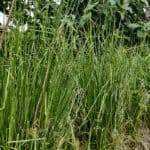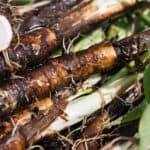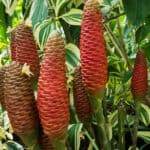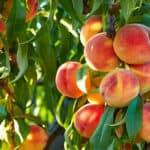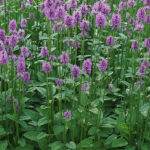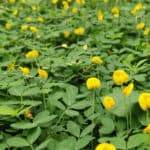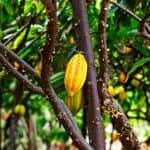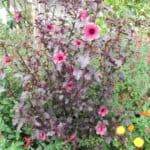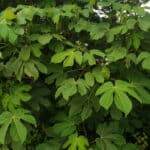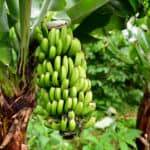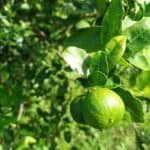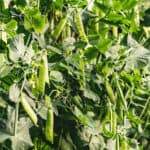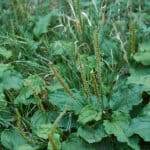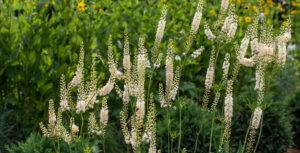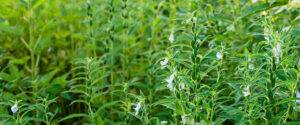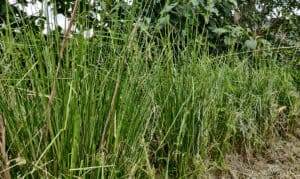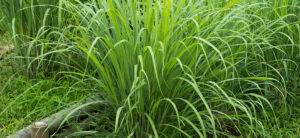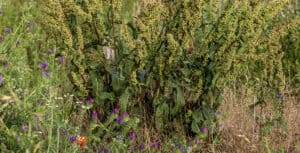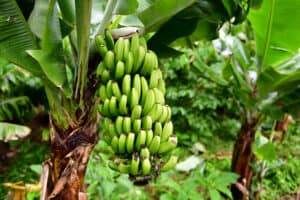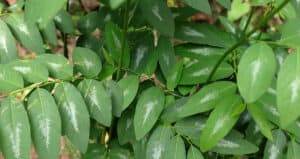The act of planting garlic is a hopeful one, a commitment to a seed, a piece of ground, and the future you might all share. It’s a patient act, too, as this commitment is made just before the cold sets in – intentionally so. You want garlic cloves to have just enough time to settle in, begin to take root, and sprout. Not so much that their green shoots break through the soil only to be frosted back. Garlic’s growth, its life, begins with the coldest, darkest days of the year. As I struggle to tend my own Winter flames, I am amazed by these fiery bulbs – hunkering down in slow growth. Their bright green antennae are harbingers of Spring, and I await them as eagerly as my first sunburn. They are the connecting piece, the thread that ties one season to the next.
Garlic in the Garden
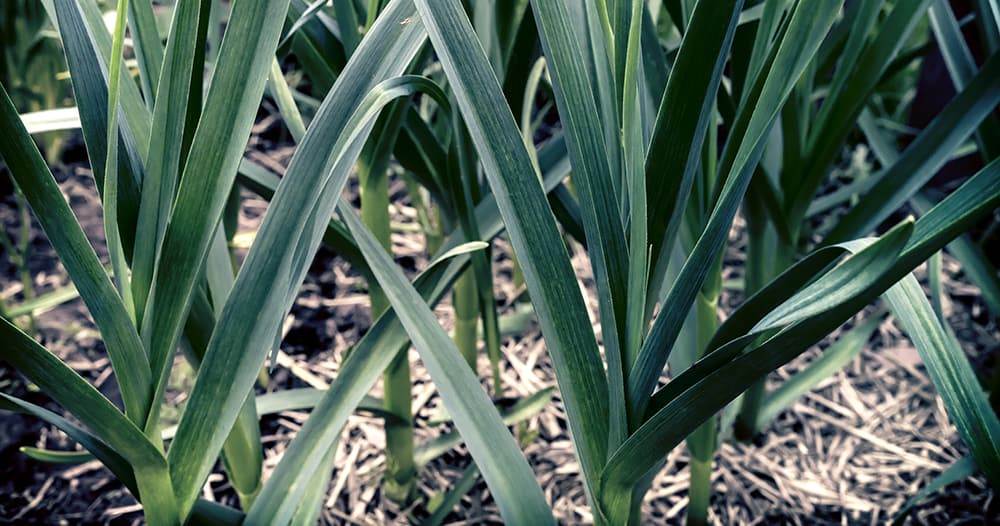
Garlic is a hearty perennial, both satisfying and relatively easy to grow (We love a confidence-builder in the garden!). It occupies the soil from mid-Fall all the way through mid-Summer, and is both beautiful and edible at many stages of its growth. You’ll quickly find that homegrown garlic is a far cry from the bland and soft bulbs found at most grocery stores. It’s spicy, pungent, and delicious. It comes in many different varieties, flavors, and even COLORS! And it has powerful medicinal properties (as an antioxidant, anti-inflammatory, and antibacterial, to name a few). For even more information on garlic, a book called Growing Great Garlic by Ron L Engeland is a comprehensive guide written with home gardeners in mind.
Hardneck vs Softneck
The major classification of garlic is into hardneck and softneck. These descriptors are just as they sound. Hardneck garlic has a stiff stem and will produce a garlic scape (an edible flowering stalk). It also tends to have fewer and larger cloves, and a more pungent flavor. Popular hardneck varieties include Chesnock Red, German White, Spanish Roja, and Music. Softneck garlic, on the other hand, has a pliable stem, perfect for braiding. It also tends to have smaller cloves, a more mild flavor, and longer storage abilities. Popular softneck varieties include Inchelium Red, Silver Rose, and Susanville.
Within those two groups are 10 sub-classifications of garlic based on clove size, wrapper color, plant height, and other factors. These include Porcelain, Rocambole, Purple Stripe, Glazed Purple Stripe, Marbled Purple Stripe, Creole, Asiatic, Turban, Artichoke, and Silverskin. And each of those sub-groups contains dozens and dozens of varieties. In short, there’s a whole nuanced and delicious garlic universe out there to explore!
Bed Prep
Garlic prefers full sun and loam soil with a neutral pH. If your soil is clayey, consider broadforking the area first to loosen it up. A worked-in 2” layer of composted manure will help satisfy garlic’s appetite for Nitrogen.
Planting Garlic Cloves
Halloween marks garlic planting time here in Michigan. We want to get our cloves in the ground before the weather gets too cold, and certainly before the ground freezes. This gives it just enough time to get established and root in before going dormant. If you have your own garlic left over, you can plant it as seed. Otherwise, garlic seed is widely available online – or ask a local farmer if they have extra bulbs. Garlic from the grocery store may not be a good choice for planting; often, it has been treated in a way that makes it not viable.
If planted, each clove of a garlic bulb will become its own head of garlic. When selecting our garlic seed, we choose the biggest bulbs with the biggest cloves. Think of these cloves as the stored energy your plant needs to grow before it can photosynthesize. Before planting, break apart your garlic bulbs into the individual cloves. Take care to not snap or damage the cloves, and try to leave as much of the papery wrapping on them as possible. This is their Winter blanket, and helps prevent them from rotting in the ground.
We plant our garlic 6” apart within rows that are spaced 1’ apart, and at a depth of 2”. Be sure to plant the cloves with the pointed end up and the flat rooted side down; otherwise, it will expend extra energy righting itself. Some years, we team up: one person uses a planting stick or dowel to poke holes down the row; the other person follows with the seed, planting, and filling in the holes. We’ve also tried pre-digging furrows, planting the cloves, and then raking the soil over to cover them. Your method will definitely depend on your soil type and the tools you have available.
** If you are interested in planting cloves specifically for harvest as green garlic, you can tighten your spacing and seed them right next to one another. Early Spring plantings also work quite well for green garlic, since it doesn’t need time to bulb up.
Mulching
Garlic responds really well to being mulched! Apply a 4” layer of straw or leaves immediately after planting. This provides extra insulation over the Winter months, holds in moisture, and keeps weed pressure down. Once Spring comes along, be sure to check and make sure the new shoots are able to grow through the mulch. If it’s too thick or matted, you may have to pull it aside.
Irrigation
Irrigate garlic deeply, but not super frequently – an inch of water weekly is plenty. The roots do not do well in soggy soils or standing water. If you notice the leaves yellowing too early, however, underwatering is often the culprit. Be sure to stop irrigating once you see the leaves begin to brown. Let the plants dry down as much as possible as harvest time nears.
Garlic Gobbles Nitrogen
In addition to a deep application of composted manure at planting time, consider either side-dressing or foliar-feeding garlic plants with a Nitrogen-rich kelp or fish emulsion fertilizer. This application should be done in early Spring as the plants are putting on green growth.
Pest Pressure … Not so much!
For those whose gardens are plagued by pests, garlic is a great option! Its pungency is helpful in deterring insects and mammals alike. In fact, planting garlic on the border of your garden can help repel creatures from coming in. A few brave insects can damage the plants – thrips and nematodes in particular. Crop rotation is your best bet in avoiding them; cover cropping, particularly with mustard crops, has been shown to rid the soil of nematodes.
Disease
If garlic has a kryptonite, it is definitely fungal disease: Botrytis, Black Mold, and, perhaps the most devastating, White Rot, can all do significant damage to garlic plantings, present and future. Sourcing healthy seed is crucial, as is rotating where you plant your garlic and onions. Once White Rot is present in the soil, there is really nothing you can do about it for years.
Harvesting Garlic: Three Vegetables in One
Green Garlic
Before the garlic plant puts energy into bulbing up (early-mid Spring), its greens are lush and fairly tender. They are delicious sauteed in stir fries and soups at this stage. If we haven’t intentionally planted bulbs for the purpose of green garlic, we will often search the patch for smaller, stunted plants to harvest. Pull the whole plant and give it a good rinsing. At this stage it looks similar to a green onion or a small leek; green and white parts alike are edible.
Garlic Scapes
Garlic scapes, the flowering stalk of hardneck garlic varieties, begin to show themselves in late May-early June. These green loopy Seussical stalks are ready to harvest when they’ve circled back on themselves and reached a length of 6-8” or so – before they begin to turn woody. Scapes can be harvested with a knife or snapped with your hands. Our favorite way to pick them, though, is by pulling them straight up in such a way that we break off a much longer piece further into the stem. Warning: this takes finesse! The payoff is not only a longer scape, but also a delightfully awkward slurping suction sound as you draw the scape upwards. It’s worth trying at least once!
** Besides providing another delicious vegetable, harvesting garlic scapes has an additional benefit: It allows the plant to put more energy into sizing up its bulb, thus giving you a larger harvest!
Garlic Bulbs
Once the 4th of July comes around, we start paying closer attention to our garlic patch. What we’re looking for are browning leaves. Each of the leaves of the garlic plant corresponds to a layer of the papery skin that wraps and protects the cloves. When ½ to ⅔ of the leaves have dried, it’s time to pull the bulbs and let them finish drying (or curing) above ground. If garlic is pulled too green, it will have too much moisture left in it to cure properly, and will likely mold. If pulled too brown, the cloves will have burst through their papery skins. While they’ll still be edible, their storage potential is greatly reduced.
An ideal garlic harvest week is a dry one. Obviously, this is not really in your control. It’s easier to dig and cure garlic when it has had a chance to dry down a bit. The leaves and bulbs aren’t carrying extra moisture, and the roots aren’t clinging to loads of wet soil. That said, you work with what you’ve got. And in many years for us, July is a wet month! Depending on the quality of your soil, garlic can either be harvested by hand or with the aid of a garden fork. Be sure to give the plants plenty of room when forking them up to avoid puncturing the bulbs. And try to be gentle when handling them in general; garlic is susceptible to bruising in the same way an apple is.
Curing & Storage
We pull our garlic plants, gently shaking what soil we can off of their roots as we go, and pile them up in the field, all facing the same way. Garlic can sunscald, so we try to keep this process quick. Next, we group the plants by 10’s. Using a 3’ length of baling twine, we tie one group of 10 plants to each end, such that we can hang it in a balanced way over rafters, a taut rope, etc. Ideal conditions for drying/curing garlic revolve around good ventilation, moderate temperatures, and no direct sunlight. A garage or workshop with a box fan is perfect. Three to four weeks of hanging and drying should fully cure the garlic. The leaves will be crispy and brown, and the bulb itself ought to be dry, on its way to papery. This curing process really helps the shelf life of garlic. Our bulbs often last us well into April, and sometimes May of the next year.
Once your garlic is fully cured, you can use scissors or hand clippers to cut the stem to about 2” in length (If you’re interested in braiding softneck garlic, don’t clip the stems!). And chop the roots, too, leaving your bulb with a short ½” mustache. As with so many Winter crops, dark, dry, and cool is the name of the game with garlic storage. Keep the bulbs in a mesh bag in your pantry or cupboard, or in an insulated garage.
Save your biggest and best bulbs for seed to be planted again in the Fall.
Parting Thoughts
Culinarily, garlic is one of the most widely-used seasonings in the world. It also has many medicinal applications. Garlic often gets overlooked as a possibility for the home garden, but getting to watch it grow through all of its stages alone makes it worth it. Add to that the fact that it’s hearty, resistant to pests, easy to save seed, and ABSOLUTELY DELICIOUS, and I think you’ve got a great candidate for planting this season. Good luck growing great garlic!



